|
Nice OP. I might just add a point about optics. You'll need some sort of binoculars to get going, but this doesn't need to be a huge investment. You'll probably want to stay away from the super cheap models, but you can get very good options starting at ~$200-300. Feel free to ask for recommendations. When you first get started, it's best to stay away from the super-compact ones as well as the ginormous models. Something in the 7 or 8x (magnification) by 40-50 (objective lens diameter) is great, since it will usually give a bright image, enough magnification to see field marks but wide enough to actually find the bird when you raise the binoculars to your eyes, and not too zoomed in that your jittery hands make it hard to see anything. Most models in this price range and above will be waterproof- you definitely want this. There are times when you will need more magnification, for example, shorebirds, distant perched raptors, ducks far out on the water etc. However, if you go with birding groups or to popular birding locations, you'll often encounter other birders who have scopes. If you really get hooked you might want to invest in a scope but this should not be your first priority if you are just getting into the hobby. Photography can be a useful tool for the beginning birder as well. Sometimes field marks are difficult to pick out in real time but easier to see when reviewing an image in the field or back home. Photographs are also becoming a great way to document unusual birds. However the multi-tasking can be hard sometimes. If you have a DSLR, you'll want at least a 300mm lens. Bridge/P&S cameras can be used for documentation as well, although they are generally have a harder time focusing on small distant objects.
|
|
|
|

|
| # ¿ Apr 25, 2024 06:57 |
|
I agree with the Sibley recommendation. I also think that a real book is going to be better than an app if you really are new to birding. The apps like iBird have one advantage which is they have a sample of sounds. A big part of birding is learning the characteristic sounds of a given species, and having the sound right there to compare is pretty great. In some cases, the birds will even respond to the sound played from your phone, which gives you a pretty good clue you picked the right bird. There are ethical considerations for this since it can cause the birds stress- do it sparingly, don't do it at heavily birded locations, or with rare or sensitive species. More in birding ethics here. For what it's worth, I'm also a professional ornithologist/evolutionary biologist/behavioral ecologist, although I got into birding at a young age because my parents were already into it. There is surprisingly little overlap between ornithology and birding- most birders do not do it for a living, and many ornithologists study just one or a few kinds of birds and have poor overall ID skills.
|
|
|
|
I think the question was more about the organizations? There are two main national ones. The National Audobon Society is more of the advocacy/conservation organization, also with some conservation research (but not like the AOU, which is our ornithological equivalent of the British Ornithological Union). The American Birding Association is most involved with actual birding, listing, field identification, etc. Audubon has state and local level organizations. I'm not sure whether other local clubs are under ABA. Rare birds sightings are reviewed by state-level committees of experts which I assume have some tie to ABA but I'm not sure about this. editted for moar BetterLekNextTime fucked around with this message at 19:19 on Aug 20, 2013 |
|
|
|
The Monkey Man posted:What's your favorite sighting ever? For what it's worth, some of the most interesting stuff I've seen while birding has been animals other than birds- I saw deer up close with my dad one time, and got to see carp jumping out of the water during their mating season. I did get to see a clapper rail last year near Atlantic City- they aren't rare, but they're rarely seen because they're almost always in the tall grass. That's a hard question. There's something in birding called a "Nemesis bird"- it's not necessarily a particularly rare species but something that has eluded you for a long time. Mine used to be Goshawk (a big grey forest hawk), and I finally got to see one a few years ago. It was pretty far away and not a very long look but still very satisfying. One of the sightings that gave me the most chills was a gyrfalcon that flew alongside my vehicle in alaska for a few seconds. Just a super bad-rear end bird. If you've ever been to an aquarium with big tuna swimming around, the gyrfalcon have the same combination of streamlined but powerful. I work with a species of grouse called the Greater Sage-grouse, and to study the behavior we have to set up blinds on their display grounds before dawn. Being there when the first songbirds (like the super-cool sounding Brewer's Sparrow) start singing, then hearing the first few male grouse fly in and start their weird rear end swish-swish bluckity-bluck display is pretty great. 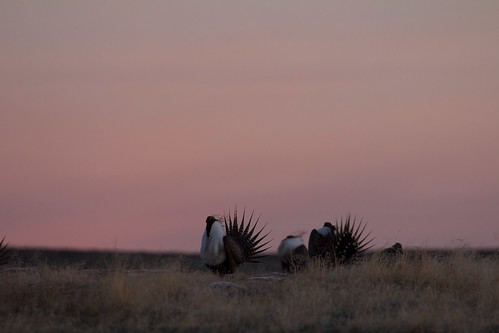 Sage-grouse displaying at dawn on Flickr
|
|
|
|
Just to expand on the "bird liars", I think the community for the most part recognizes a couple kinds of people- birders that should know better, and those that don't. If you are clearly a beginner and accidentally mis-ID a bird, most people are pretty patient with this kind of mistake, and will try to be helpful in explaining why your rare bird X was probably a more likely bird Y. If you are suspected of continually posting rarities that are never corroborated by yourself (with photos) or by other people, you'll basically be dismissed by the community. This is actually something of a service to be self-regulating like this- since these sightings, whether on eBird or listerv messages, are seen by people outside of the local community who would like to know something about the likelihood that the sighting is authentic in case they might want to travel in to see it.ammo mammal posted:There are shitloads of NZ hawks where I live now, and falcons too though they are very rare. I've been thinking of climbing a tall tree and building a little platform with a motion-activated camera, and then nailing a rabbit up there every so often to check out the carnage. Think that would work? This isn't much different than a terrestrial game cam- just don't set it up close to a nest it should attract scavenging raptors.(you're talking about a dead rabbit right?) You might want to check with whatever the wildlife agency is to make sure there aren't any regulations to be aware of. BetterLekNextTime fucked around with this message at 21:51 on Aug 20, 2013 |
|
|
|
greenchair posted:Is there any time of day that's better for birding, or are some times of day are better for some species rather than others? Do you typically go out and see whats there, or do you "hunt" a particular species? Early morning is almost always better- birds sing more then, and are more active as they need to go eat something after not eating all night. Not that it's not worth going other times, but you're likely to see and hear more from dawn through mid-morning. The exception to this might be coastal shorebirds when timing it with the tide may be more important, ducks where it doesn't matter much, and owls. Sometimes I go after a few specific target birds, and other times I'll just go out to see whatever, or go for a "big day" to see as many species as possible. Maybe your bird was an Indigo Bunting? Wayne Gretzky- it's not an entirely a who-knows-who network thing at least in areas where there are a lot of birders. If an unusual bird gets reported, the word gets out quickly and more often than not at least one other birder gets to see it as well. If there's a pattern where someone's odd sightings never get seen by others, or the person is not very helpful in reporting them quickly or with clear location information, it does raise alarm bells. People only have to deal with their own confidence if it's their own listing, but when the sightings are reported on public lists it's good to have some checks what gets reported.
|
|
|
|
Wayne Gretzky posted:How many good normal sightings do you think I would have to have before someone would believe me if I said I saw some really crazy poo poo ? If you got a decent photo, there wouldn't be an issue. Without a photo, if your description of the bird was really careful, people would still believe it. This would mean attention to the relevant field marks and behavior and consideration of the more common species that are similar. In many cases it's not a trivial undertaking to ID an out-of-range bird- you can imagine the issue with a million common birds and some variation in what they look like- maybe one just sat in oil, has a deformed bill, weird feather wear...
|
|
|
|
As razz said, the social and bookkeeping aspects are basically as important as you want them to be for your own enjoyment. Except for the super-hard-core twitchers that only care about numbers, the birds come first for most people. I enjoy solitary birding just to get some alone time and emersion with nature. Birding with other people is also really fun, and I definitely learn a lot more too, whether it's being with people more experienced than me who can help me ID things, or if I'm explaining things to other people, often I find new ways to see the important field marks or pick up on details I hadn't really retained before. There's hardly ever a bad day birding- even if it's not species rich there will usually be some good or favorite bird that you get to see, and even if that's not the case, you can spend time watching common birds do their thing. Snowy Egrets are dirt common where I am, and I never get tired of watching them look for food. The eBird data collection is just a way to contribute to our understanding of bird populations. Previous data collection has either been fairly local in space (e.g. one wildlife refuge), or time (Christmas Bird Counts around the new year, Breeding Bird Surveys). eBird gives us ways to estimate populations year round and all over the country. Some places have pretty good coverage, but others don't and any sightings would be really valuable there. In Wyoming there are entire counties that zero to very little coverage for months at a time. I'm in the Bay Area and might be up for some birding occasionally. No Real Pattern- looks like you might be as well?
|
|
|
|
There are just a handful of real competitive birding events (like the World Series of Birding) where there might be sponsorships. It's much more common to have charity events, where teams get pledges for the number of species they see, and the money goes towards some conservation organizations. It's definitely fun to find something rare, especially during some organized count like the Christmas Bird Count. Most CBCs will have a countdown dinner at the end of the day, and some of them start by asking whether people have seen the common birds, and save the more and more rare for the end to build anticipation (rather than going in taxonomic order which is how other people do it). It's super sweet if you get one that's not even on their list because it's never been seen on the count before. One of the counts I do also gives a "best bird" prize, but I don't think it's actually a prize, just bragging rights. There are birders who lead tours or can be hired as guides by out of town birders. I suppose they might list in their qualifications if they have a lot of county/state first sightings, or if they have one of the biggest lists for the state.
|
|
|
|
Wayne Gretzky posted:
Sort of, and it depends on the bird. Some birds are really spectacular at foraging (seeing a peregrine falcon or brown pelican or something dive on their prey is pretty bad rear end). Seeing a sage-grouse wandering around foraging would not be as exciting, but seeing a male inflate himself and display on the lek is pretty special, and from a personal perspecitive would probably be the "special version" that you'd want in your collection. Winter wrens are drab little birds but have one of the most spectacular songs, so that would count for a lot. Some observations of breeding behavior, such as building a nest, feeding young, tending very recent fledglings, are important scientific data that can be used to define the locations and habitats the birds use for breeding. EBird can take some of this, but it's mostly used in more professionally organized Breeding Bird Surveys, as well as locally produced Breeding Bird Atlases. Some people keep lists of birds they've seen loving or birds that have pooped on them, but this is only for their own tongue-in-cheek fun.
|
|
|
|
My dad is one of those people, spending his retirement years doing a lot of awesome trips. We have pretty good birds in the temperate US, but a trip to the tropics is pretty eye opening. There's a bit of a counter-movement to all the travel- some people find it ironic that the generally eco-minded birder is using up lots of fossil fuels just to see birds. Some people keep bike-walk only lists for their city or county.
|
|
|
|
Wayne Gretzky posted:Can you please explain what this is? 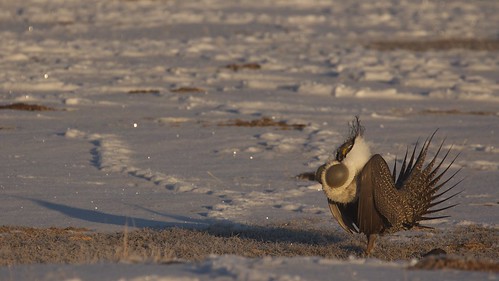 IMG_2175 - Version 2 on Flickr  IMG_7483 - Version 2 on Flickr  Snowy Sage-grouse on Flickr "Normal" posture 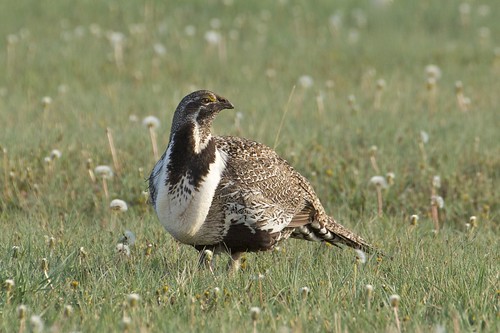 grouse&dandylions 080 on Flickr A few kinds of birds, including some grouse, move air from their respiratory system into their mouth and down into their esophagus to inflate it like a balloon. It makes a big resonating chamber- we don't know all the details about what it does to the sound but it should be helping the males pass louder low frequency sounds into the environment. These sounds bring females into the display grounds and females may also choose males to mate with based on aspects of the sound. There is also a visual component that goes along with it for the grouse, but not some other birds (pigeons, bitterns). Video here. (this the bird I'm studying now) BetterLekNextTime fucked around with this message at 22:20 on Aug 21, 2013 |
|
|
|
Sort of! Except remember it's dudes. It's basically just thin flexible skin that they can choose to show or not.
|
|
|
|
Wayne Gretzky posted:How come you like the birds' he-ooters so much? Just cool looking? I notice your "e-name" also references them. I don't really want to derail too much from a birding thread, but, very briefly, I study behavioral evolution (among other things), basically how certain traits are beneficial. One subset of this is sexual selection, which relates to traits that help males compete for mates, and is responsible for a lot of the most eyecatching and ear-pleasing appearances and displays in animals. Grouse in general are good for a lot of reasons because their lek mating system makes studying female choice relatively clean (females are just picking sexy dudes) unlike most birds where they are choosing both sexy dudes and good dads, and also it's easy for pervy ornithologists (pornithologists?) to watch their mate choice happen since it's all out in the open all in one place. My PI/collaborator got interested in them to study the importance of social skills in sexual selection (among other things)- something that had been missing from most of the past 100+ years of study in this field. The he-ooters (we call them breasticles, but whatever) do weird things to the sound radiation patterns and we are studying how males beam their sound at the females during courtship, and one of the things we're trying to do is measure the relative importance of being loud versus just being good at aiming the loud part of their sound at the female. We also use robot birds, but that's a tale for another day.
|
|
|
|
Tardigrade posted:Phasianids are awesome. They're a cautionary tale for what happens if sexual selection runs amok. Bring them carry-on whenever possible- it would suck to have them stolen out of your luggage or lost if your bag is lost. I have occasionally been searched with binoculars in my carry-on- at US airports it's almost always been when my bag has has a P&S camera + bag full of chargers/cables + portable HD + Bins+ ipod, so it's hard to say it was the bins fault. I've had bins cause a search internationally, but it could be they were just looking for an excuse. If I have room I usually bring an old beater or compact pair of bins in my luggage if I'm going on a long ecotour just in case I lose/break my main pair.
|
|
|
|
If anyone is looking for a bird ID app, Peterson's is on sale now for $5 (normally $15). I've never used this one- has anyone else here given it a try? I have iBird and Sibley.
|
|
|
|
Declan MacManus posted:Is being a top birder considered a high honor? Only among birders. But it's just as good if not better to be someone known for helping new people get into birding or otherwise support the birding community.
|
|
|
|
Kawalimus posted:What do people think about stuff like using screech-owl tapes to scare out birds? It seems like more and more people are doing this. I find it kind of cheap and also discourteous when there are a bunch of other birders around. In the spring myself and a couple other guys were birding at a good warbler area and one of us thought we had a bay-breasted and I was getting a glimpse of a Cape May. Then someone right near us started doing a screech-owl tape and all the birds went bananas and we never got good looks. It was just annoying. But it seems like so many of the top birders do it. So I don't know. It's still fairly standard to use playbacks. There's kind of clashing trends- people are becoming more aware that playbacks have negative effects on birds, but at the same time, technology is making it that much easier to do them everywhere anytime. It's definitely a jerk move to ruin someone else's birding experience- if there are other birders there alert them to the fact you are about to do a playback. Also try to avoid doing them in places that are visited by birders frequently (e.g. the main boardwalk to the observation platform at the popular national wildlife refuge), since there will be more cumulative stress over time if the birds get various OMG Intruder/Predator playbacks day after day.
|
|
|
|
BeastOfExmoor posted:
Yup- if you get on the local sightings list serve people might reference places like "Frank's Dump" or "Mt. Trashmore". Hopefully the local Audubon will have a list online of how to get to those places. re: pishing- sometimes it works better than others. Some bird are much more prone to respond- wrens & chickadees & kinglets will often come in to investigate, a lot of sparrows seem to pop up for 2 seconds then disappear again, and a lot of birds will just plain ignore you. Don't take it personally. Sorry razz- what a bummer!
|
|
|
|
I'm heading back to the west coast today after visiting family in NC. This morning from the porch: 3 Summer Tanagers (1 male, 2 female/juv- great looks) 2 Yellow-billed cuckoos- (prob juv, best look I've had in a long time) Brown Thrasher Red-eyed and White-eyed vireos (adults and fledglings) Parula warbler Eastern wood-pewee Great-blue Heron (heard) Cardinals, eastern bluebirds, Carolina Wrens, Carolina Chickadees... I think 23 species in all, starting at ~10AM. Fun to see some eastern birds again! I don't really know what to say about the birders vs. photogs, besides that it can go both ways.
|
|
|
|
I've probably told this story in this thread before, but at the "public" sage-grouse lek near where I work there was a photographer in a gilly suit taking photos of the sage-grouse. When he had enough, he just stood up and walked through the lek to his truck, scaring all the birds. Birders definitely have their own thing going sometimes. Trespassing is probably more common by birders than photographers (I'd guess it's easier to run away with just a pair of bins than a big lens and tripod). Also, parking in dumb-poo poo places along busy roads. Lots of birders overuse playbacks to attract birds closer or confirm ID's, and has been mentioned, this is not a positive thing for the birds.
|
|
|
|
ntrepid posted:I'm in western West Virginia and new to birding. When can I expect to see some migrating birds? Looking forward to seeing and hearing some new species this fall/winter! Probably right now! Not sure you get many shorebirds there, but they're usually the first to come through. Here in California we're getting the warblers, flycatchers, etc. Raptors are just picking up- those are a little later. Winter resident sparrows may peak in a few weeks as well. Winter irruptives could wait until the first real winter weather hits. These are all just generalities, but this is definitely the time to be looking for migrants (and cursing juvenile-plumaged birds that don't make much noise). Best thing would be to start snooping on the local bird sightings email lists- at least one WV list shows up on Sialia.net (scroll to the bottom). Alternatively, check out ebird for birds you're interested in seeing, and look at when they tend to arrive.
|
|
|
|
There's always Birds of North America Online. It's the "full" version of the All About Birds accounts. Requires subscription, but you can often get a year's access for joining your local Audubon society or the Cornell Lab of Ornithology. Also most university libraries have institutional subscriptions so if you have library access (or can borrow a friend's proxy), you can get it for free.
|
|
|
|
December Octopodes posted:This seems like a cool thread, I have a couple of questions. With the Ivory-billed, it's definitely been a roller-coaster. Everyone thought it was extinct. It's possible that the sightings were of the last super-old birds that died. I've not been to either the Arkansas or Florida sites, but apparently it is super hard terrain and it's not impossible the birds are still there. That said, you'd think that with all the effort someone would have come up with hard evidence. I know some of the people who were heading up those searches (and who saw the birds), and I do trust their sightings. However, they (esp Cornell) invested so much prestige in the search that even if they were wrong about it, they would have a hard time admitting it. It would have been really cool if they were still alive, but even with such a small population there long-term persistence would have been really perilous.
|
|
|
|
Balaeniceps posted:
I'd say it definitely skews middle-aged and older, but overall there's not much of a sex bias. However, I've seen some recent articles about how the bigwigs are almost 100% men (by looking at things like the make-up of bird records committees- the people who decide whether some rare bird was actually what someone thought it was). It was kind of an interesting discussion, basically how there's still quite a bit of lingering sexism in the field plus in general women not being quite as assertive/confident/overconfident about their birding skills (more likely to qualify their observations with "I think it was a", etc).
|
|
|
|
There must be some young lady-birders out there. I do the hiring for my project, and the applicant pool (wildlifer types or ecology/animal behavior types) is usually significantly skewed female (maybe 60:40 or more). I realize that grouse job =/= birding but there is some overlap, and a decent number of our crew have been pretty avid birders.
|
|
|
|
I don't remember how much this features Ted, but there's a book Parrot without a name that details the search for unknown species of birds in South America. Yeah- Ted was kind of a genius when it comes to bird sounds. I'm pretty sure he's still the single most prolific recordist in South America and is responsible for much of the distributional information on birds there. He's also one of those guys who really followed his passion and died doing what he loved. He wasn't faculty or permanent paid staff anywhere and was getting by on small grants and collaborations. edit: re: finding fall warblers- besides just getting out and looking in promising woodland areas, maybe check ebird or tap into local networks to see where people tend to go to look for them. It's a little different on the west coast- stuff tends to fly until they hit the ocean, so groves of trees close to the coast collect migrants. In the central valley it's still hot and dry so definitely riparian areas are good. Sometimes isolated groves, or forest that's on the south end of a large inhospitable region like a lake or something can be good since things tend to stop there. Southern ends or choke points of valleys can be good as well. Getting out there when the weather changes can be good- I can't remember the best conditions for grounding migrants, but something like a front coming up from the south might stop them for a day or two, while a big front coming from the north might bring stuff through but also push birds south as well. BetterLekNextTime fucked around with this message at 17:52 on Sep 11, 2013 |
|
|
|
800peepee51doodoo posted:Do you know if there is a way to filter or search for lists people have submitted for specific hotspots by date? Like, for instance is there a way I could look up what people have reported seeing in the last 7 days at X location? The only way I could figure out how to do that was to search for some common species on the map and check the recent lists. Obviously, this isn't going to get everything because a lot of people won't report the common stuff but will report the less common species. I'm not sure about 7 days, but if you zoom in enough on the map to see individual reports, those <30 days are in red and the rest are in blue. It could be some of the 3rd party programs/apps are better for specific sorting/filtering like that. Unfortunately I've not used those yet so don't know for sure.
|
|
|
|
/\/\/\/\ edit- I was definitely excited about green jays, grackles, etc that are common there.Kawalimus posted:If I go to Texas(the right part anyway) I want to see a GREEN JAY!!! Among many others of course. a mighty fine looking bird 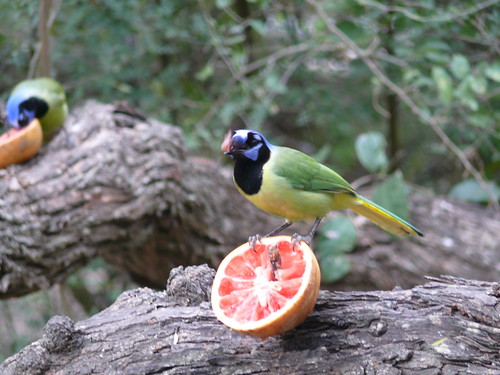 Green Jay on Flickr Lower Rio Grande Valley is pretty awesome for all sorts of birds. I went in the winter a few years ago. random photo dump- a few others (before I had a DSLR): Chachalaca 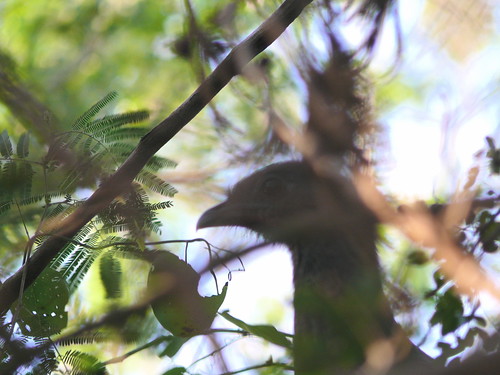 Chachalaca by alankrakauer, on Flickr 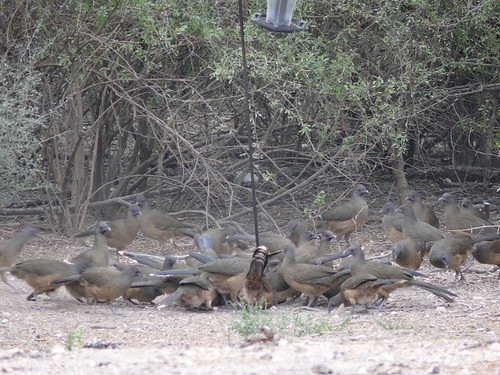 Chachalaca Swarm on Flickr Great-tailed Grackle  Great-tailed Grackles on Flickr Long-billed Thrasher 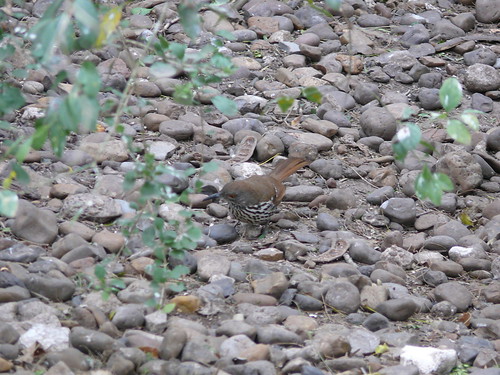 Long-billed Thrasher on Flickr Clay-colored Robin  Clay-colored Robin on Flickr Wild Muscovy Ducks 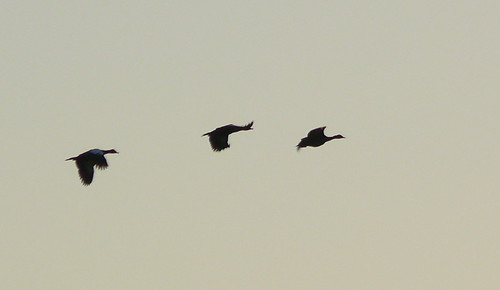 Muscovy Ducks on Flickr Pyrruloxia 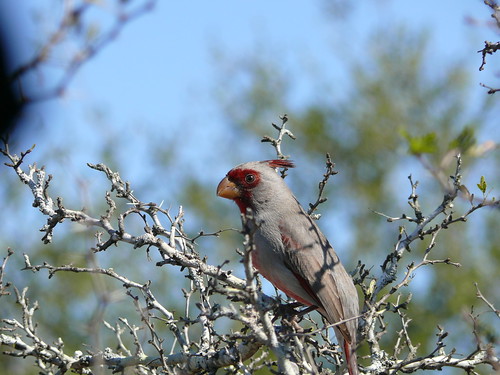 Pyrrhuloxia on Flickr Have fun Razz!
|
|
|
|
I'd agree with the Pectoral ID. I might go with Black-bellied on the large plover based on what looks like a relatively heavy bill, but I wouldn't put a ton of money on it. Always nice if you can get a glimpse of the armpits in flight or during a wing-stretch: black-bellied have black axillaries and goldens do not.
|
|
|
|
EPICAC posted:My wife and I are planning on visiting her sister and nephews in the Dublin area for Thanksgiving. While we're there, I'd like to get in a bit of casual birding. Don't know the answer, but you might start here: http://www.dublinbirding.ie/ Maybe you can find a link to an email list somewhere and post a question. Birders are generally really helpful in answering questions about planning visits. It helps if you specify a little bit about what you want (particular species or habitats you'd like to see).
|
|
|
|
stubblyhead posted:Birds are pretty awesome, and I like them a lot. We mostly get juncos and chickadees in our yard though Stellar's jays and rufous (I think) hummingbirds pass through pretty frequently too. Probably the most memorable sighting in my yard though was about two years ago when I saw either a Cooper's hawk or a peregrine falcon going to town on a starling right in my front yard. It had just snowed, but after it flew off there was not even a speck of blood visible, just a small pile of feathers. I think that's fine- a big part of bird lists is keeping up with the taxonomic changes.
|
|
|
|
I don't know the exact answer to your question, but it could be due contention on the naming side (what should be elevated to order status), and/or to updates in the estimated phylogenies that might put cassowaries more or less closely related to ostriches. Ratite phylogenies seem like they are getting revised fairly frequently. This is definitely a case where wikipedia could easily not be self-consistent across or even within articles. Unfortunately I don't actually know what the authority is- there's Clements' checklist that shows cassowaries in Struthioniformes. It can be difficult enough to determine what a species is, so figuring out which groups are families vs. orders (vs. superfamilies, suborders...) is definitely somewhat subjective. In other news, have a birding video game/quiz from Swarovski (saw this on the Eagle Optics feed). Note that the silhouette doesn't match the bird that's pulled up for the question.
|
|
|
|
InternetJunky posted:I think I've settled on black-bellied for this one. I received this reply from a birding mailing list I posted on, and it sounds like they know what they are talking about : Vesper sparrow? I'm not awesome with sparrows either, especially mid-contintental ones, but the pink bill, rufous shoulder patch, eye ring, and what looks like could be white outer edging on the outer tail feathers would be consistent. I went out yesterday to try for one of the blue-footed boobies that have been seen up and down the California coast, but struck out. Lots of birders out there. Funniest thing was a couple of non-birder women were there who were talking to a fairly shy college-aged male birder. One of the women was pretty well endowed and spilling out of her shirt, and the guy was too embarrassed to say what bird everyone was looking for.
|
|
|
|
InternetJunky posted:The consensus from other sources is Vesper for both pictures as well, so good job guys. Apparently I have a long way to go with IDs. We definitely need something like the O'Brian shorebird guide but for sparrows. The Sparrows of North America book is definitely most useful if you already know what the bird is.
|
|
|
|
BeastOfExmoor posted:As long as we're making requests, us west coast folks who reside close to salt water could really use a guide to Alcids. Perhaps video guide to take into account the fact that 90% of the Alcids I see are in flight and I'm trying to make my judgment based on wing length and flapping speed. I was so annoyed when I realized the Peterson Sea Watch book was east coast only That would be awesome. I feel like there's a lot more variation in those guys than ever shows up in the field guides. Even good looks at a floating murrelet can be pretty hard. I don't know how the pelagic guides figure out those tubenoses...
|
|
|
|
I enjoyed The Big Year movie, but I went in not expecting it to match the book very closely. Congrats on the birding trip! Feeders will be a great for learning the birds- I'd also recommend wildlife refuges with water features (waterfowl impoundments, coastal estuaries, etc), as some of the ducks, herons, etc stay still pretty well and are large and colorful. They also lend themselves to photography if you have a digital camera. You might look for family/youth oriented birdwalks from your local bird club or Audubon society as well. Our local one has a monthly "PB&J" birders walk for kids. Anyway, that's awesome you are doing this! For capitalization, birds are one of the few critters that gets their english common names capitalized. So a Blue Jay (Cyanocitta cristata) can be capitalized, but a generic jay is not, nor is a blue jay (meaning a jay that's blue) which would also be lower case.
|
|
|
|
razz posted:Well I am back and got to see lots of new birds out West that I had never seen before. I took a million pictures that will take me FOREVER to get through but eventually I'll post some. I'm glad to see this thread is still going strong! Welcome back! Sounds like an awesome trip. By the way, Sage Sparrow just got split so make sure you pay attention to where you saw it.
|
|
|
|
hey santa baby posted:
Yes- probably the eastern form (Myrtle warbler), with the bolder mask and white throat.
|
|
|
|

|
| # ¿ Apr 25, 2024 06:57 |
|
I probably shouldn't say "eastern" since the breeding range of Myrtle extends farther west through the boreal forest into Alaska. If anyone's interested there's been some recent work on the species complex- I guess it's important enough that some science journalists have written about it (and of course gotten it wrong). Fairly in-depth blog post about the controversy here.
|
|
|







